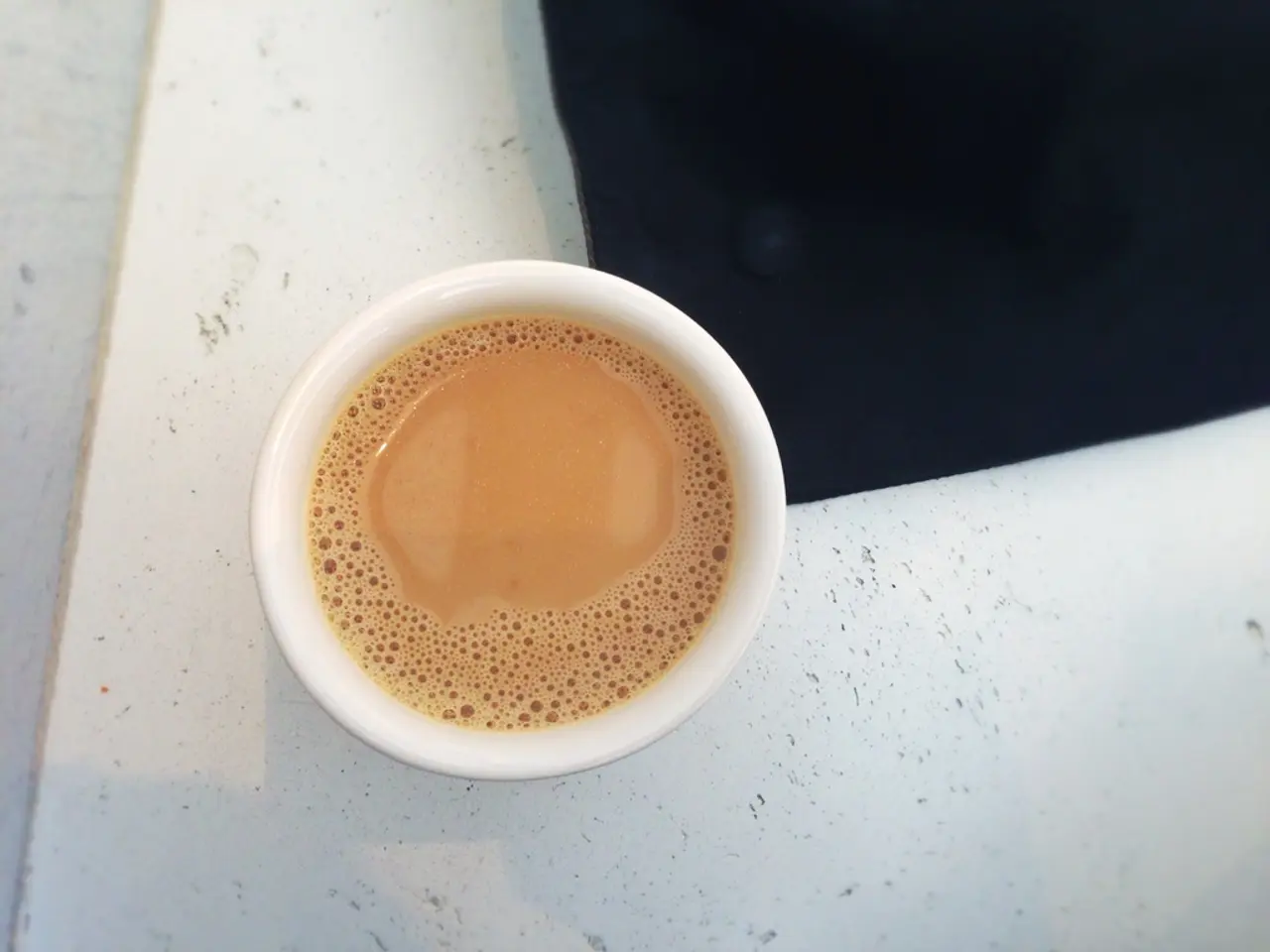Japanese Tea's Groundbreaking Voyage: Exploring the Latest Developments
In the late 12th century, the Buddhist monk Eisai introduced matcha tea to Japan, bringing with him not only the tea seeds but also the Zen Buddhist concept of mindful tea preparation[2][5]. This marked the beginning of a unique cultural journey that has seen matcha evolve from a simple beverage to an integral part of Japan's intangible cultural heritage, known as the tea ceremony or Chadō[1].
The tea ceremony, which originated in the 16th century, underwent significant refinement under tea masters such as Murata Juko and Sen no Rikyu. Murata Juko advocated for using everyday utensils for tea, making it more accessible beyond the elite samurai class. Sen no Rikyu, on the other hand, emphasized the aesthetics and spiritual depth of the ceremony, with principles like harmony (wa), respect (kei), purity (sei), and tranquility (jaku)[1][2]. These values reflect Zen Buddhist influence and stress mindfulness and the beauty of the present moment.
The cultivation and processing methods of matcha also changed in Japan. From the late 16th century, Uji near Kyoto became a notable tea-growing region, where shading tea plants before harvest produced a sweeter, fresher tea. The steamed leaves were then stone-ground into the fine powder known as matcha, which differs from Chinese methods and contributed to Japan’s unique tea culture[1].
Culturally, the tea ceremony is not merely about drinking tea but an elaborate ritual of hospitality and aesthetics designed to create a serene atmosphere distinct from everyday life. It also became a marker of social identity and refinement, especially from the late 19th century when Japan sought to define a national culture separate from Western influences. For many Japanese, particularly women managing households, mastery of tea ceremony skills symbolized civility and moral propriety[1][2][5].
In modern times, matcha remains central to the tea ceremony but has also become a global flavor trend. While this popularity has brought economic growth and expanded matcha production in Japan, traditional practitioners hope the increased interest also encourages appreciation for the ceremony’s deeper spiritual and cultural meaning rather than just the beverage's flavor[3][4].
Dunkin' Donuts' introduction of a matcha latte to its drinks menu last year signifies matcha's true arrival as a cultural crossover. Innovations in Japanese tea culture include "pourover" tea preparation, similar to hand-dripped coffee, and the use of matcha in various products like supplements and smoothies. The Aeropress, traditionally used for coffee, is now used to brew tea in Japanese cafes.
It is important to note that all tea, including those consumed in Japan, comes from the leaves of the same plant: Camellia Sinensis. Matcha is ground into a powder early in its processing to create its iconic bright green dust. Other niche varieties of Japanese green tea include gyokuro, genmaicha, and hōjicha.
The diversity of flavor and appearance of green, oolong, and black tea is caused by the tea's preparation process. Tea has even become a part of the craft cocktail scene in Japan, with tea-infused cocktails being offered in tea shops. Despite its global popularity, matcha remains deeply rooted in its Japanese origins, a testament to its enduring cultural significance.
References:
- Nippon.com. (2021). The History of Japanese Tea. [online] Available at: https://www.nippon.com/en/features/g201/tea/ [Accessed 15 Mar. 2023].
- JapanExperterna.se. (2020). The History of Japanese Tea: From Zen Buddhism to the Tea Ceremony. [online] Available at: https://japonexperterna.se/the-history-of-japanese-tea-from-zen-buddhism-to-the-tea-ceremony/ [Accessed 15 Mar. 2023].
- The Tea Association of the U.S.A., Inc. (2023). Matcha Tea. [online] Available at: https://www.teausa.org/tea-information/tea-basics/types-of-tea/matcha/ [Accessed 15 Mar. 2023].
- MatchaBar. (2023). The History of Matcha. [online] Available at: https://matchabar.com/pages/history-of-matcha [Accessed 15 Mar. 2023].
- The Tea House. (2023). The History of Matcha. [online] Available at: https://www.theteahouse.com/blogs/tea-blog/the-history-of-matcha [Accessed 15 Mar. 2023].
- The development of Japanese tea culture is deeply intertwined with Zen Buddhism, as the monk Eisai introduced matcha tea in the 12th century, infusing it with the principles of mindfulness and introspection.
- In its initial stages, matcha was merely a beverage, but over time, it transformed into an essential element of Japan's intangible cultural heritage, known as the tea ceremony or Chadō.
- The tea ceremony, which originated in the 16th century, evolved under the guidance of tea masters like Murata Juko and Sen no Rikyu, who emphasized harmony, respect, purity, and tranquility, reflecting the influence of Zen Buddhism.
- Japanese matching tea, unlike Chinese methods, involves shading tea plants before harvest to produce a sweeter, fresher tea and stone-grinding the leaves into a fine powder known as matcha.
- Beyond being just a social practice, the tea ceremony is a reflection of Japanese culture, lifestyle, and art, embodying the aesthetics and values of Japan’s long-standing tradition.
- In modern times, matcha has expanded beyond its traditional use in the tea ceremony, permeating global cuisines, food-and-drink trends, and even home-and-garden products, as seen with the use of matcha in supplements, smoothies, and craft cocktails.
- The increasing popularity of matcha has led to innovative tea-preparation methods, such as "pourover" tea preparation and using the Aeropress to brew tea in Japanese cafes, further highlighting Japan's commitment to sustainable living and the fusion of tradition with modernity.
- Despite its global appeal, matcha remains deeply rooted in its Japanese origins, a testament to the enduring cultural significance of the drink that continues to shape Japan's food-and-drink landscape and resonate with people around the world.




